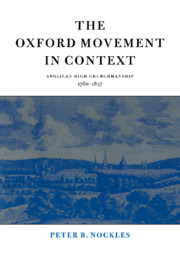Book contents
- Frontmatter
- Contents
- Preface
- List of abbreviations
- Historiographical introduction
- 1 Church and state: the politics of High Churchmanship
- 2 Antiquity and the rule of faith
- 3 Ecclesiology: the apostolic paradigm
- 4 Spirituality, liturgy and worship
- 5 The economy of salvation: sacraments and Justification
- 6 The old High Churchmen and Tractarians in historical relation
- Conclusion
- Select bibliography
- Index
Historiographical introduction
Published online by Cambridge University Press: 23 September 2009
- Frontmatter
- Contents
- Preface
- List of abbreviations
- Historiographical introduction
- 1 Church and state: the politics of High Churchmanship
- 2 Antiquity and the rule of faith
- 3 Ecclesiology: the apostolic paradigm
- 4 Spirituality, liturgy and worship
- 5 The economy of salvation: sacraments and Justification
- 6 The old High Churchmen and Tractarians in historical relation
- Conclusion
- Select bibliography
- Index
Summary
HISTORICAL AND FAMILY CONTEXT
This study will involve a historical re-evaluation of the Oxford Movement from the 1830s to 1850s in the context of a rich and varied ‘High Church’ tradition within the Church of England. As an episode in the cultural, intellectual and ecclesiastical history of the nineteenth century, the Oxford Movement has never lacked historians. However, much of the historiography of the Movement until recently has been shaped by either Anglo-Catholic partisans or Protestant detractors.
Apart from the contemporaneous accounts by A. P. Perceval and William Palmer of Worcester College, the first accounts of Tractarian Oxford were given not by its heirs but by critics or renegades such as J. A. Froude and Mark Pattison. Thomas Mozley's Reminiscences (1882) was the work of a sympathetic one-time disciple but it was whimsical and eccentric as well as indiscreet enough to be regarded as a degradation by the surviving leaders of the Movement. Yet though notably hostile sketches of John Henry Newman's leadership of the Movement by his brother Francis and by Edwin Abbott and Walter Walsh followed in the 1890s, much of the subsequent historiography bordered on Anglo-Catholic hagiography.
The primary focus of Tractarian historiography has been on the Movement's leaders: Newman, Froude, Keble and Pusey. This historiography presupposed that the ‘Tractarians’ represented the dominant group within Anglicanism after the rise of the Movement from 1833 onwards. Although historical attention has also been given to the Evangelicals and ‘Broad Churchmen’, ‘the old High Church party’, as distinct from the Tractarians, has been comparatively neglected.
- Type
- Chapter
- Information
- The Oxford Movement in ContextAnglican High Churchmanship, 1760–1857, pp. 1 - 43Publisher: Cambridge University PressPrint publication year: 1994



